Now, I don’t know exactly what’s going on, because apparently we’re flying in the face of Newton’s laws
Grant Imahara
So according to the Mythbusters, they violated Newton’s laws in this episode. Presumably they don’t really believe this, or else they would be on their way to Sweden to accept their Nobel prize. I have to say, I find it a bit odd that they bring in experts to consult on sound effects, but not physics; rather they let Grant make stuff up. At least they have enough honesty for him to preface his comments with “I don’t know what I’m talking about”.
All right, here’s a go at an explanation. Us fluid dynamicists have a great tool for these types of analyses to keep us from getting all wrapped up in the details: control volume analysis.
Basically, by looking at the air into a control volume compared to the air leaving a control volume, we can calculate the force on the air in the control volume, and by Newton’s third law, the force on the objects in the control volume.
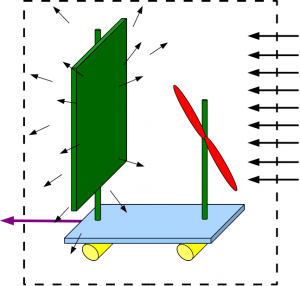 |
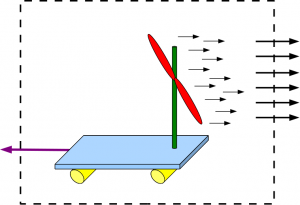 |
So a normal sailboat, going with the wind, will “catch” the air blowing into the control volume in the direction of motion, converting the momentum of the air into its own momentum. In an unmodified swamp boat (or a jet skateboard), air is leaving the control volume in single direction; therefore, there must be a force on the air in that direction; therefore, there must be a force on whatever is moving the air in the opposite direction. At the end of the day, in both cases air is being accelerated to the right, propelling the craft to the left.
When fan is turned around and the sail is put up, the air is redirected, mostly to the sides. if the air leaves the control volume more or less equally in all directions in the plane of the sail, the area integral will sum to zero (contributions in opposite directions will cancel each other out). If the fan is blowing hard enough (and the sail cooperates), I can imagine that the air would be deflected back towards the fan and leave the control volume to the right, resulting in the observed forward thrust.
Note, this also explains why the swampboat was turning wildly, because the air was favoring one side of the sail or the other, and leaving our little control volume in an unbalanced manner; imparting a sideways force.
I tried to think of a good non-fluids analogy, and here’s the best I could come up with. Hopefully, it is relatively intuitive that if you were standing on a skateboard or whatever, and threw tennis balls off of it in a particular direction, you would move in the opposite direction. Newton says so! Specifically, conservation of momentum. In order to maintain your initial zero momentum, the momentum you impart to the balls will be canceled out by your momentum in the opposite direction.
Okay, if you’re still with me, imagine erecting a board on the skateboard, and now throw the balls at the board. If the board was very sticky, and the balls didn’t rebound (or deflected sideways), then they would have the same velocity as the skateboard, which would have to be zero to maintain the system’s initial zero momentum. If they reflected perfectly elastically, they would have the same velocity that they were thrown at, completely reversing the acceleration of the skateboard to compensate (this would be equivalent to throwing the balls the other way, straight off of the skateboard). Say they rebounded less than elastically, or sometimes rebounded to one side or the other; then we’d have a situation more analogous to the fan-powered sail; thrust in the “right” direction, but not nearly as powerful as if the sail wasn’t there.
This isn’t a perfect analogy, because the tennis balls are traveling on the skateboard before they get thrown, whereas the air that the fan is blowing is being pulled from the surroundings. That being said, since the air is being pulled more or less from all directions, it is not contributing significantly to the thrust.
If the fluid dynamics of sailing is something that interests you, check out how to sail into or faster than the wind!

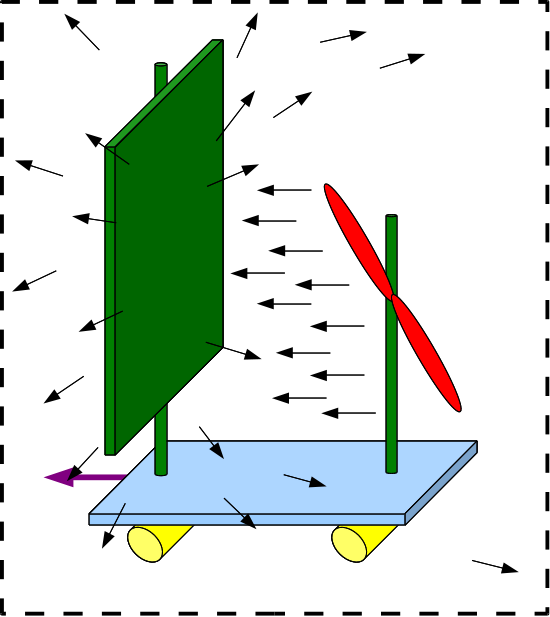
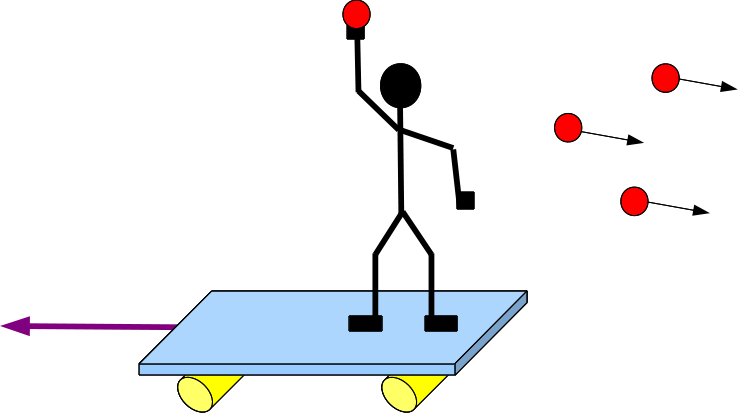
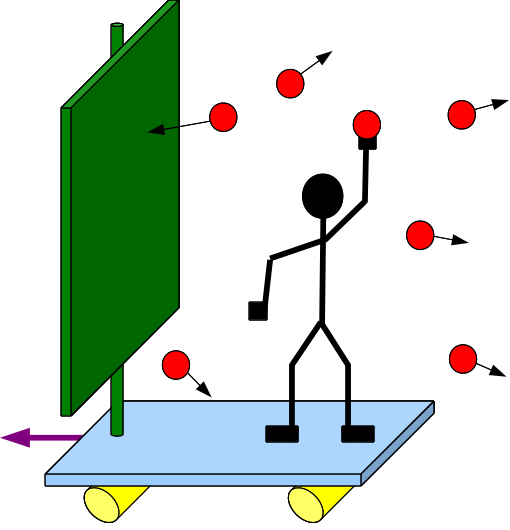

Hey,
I understood this using the control volume explanation, but can you explain this using Newton’s laws? It is killing me and I can’t go to sleep.
Would the force on the fan (pushing the boat backward), can the force on the sail (pushing it forward)? And what is the relevance of the big sail as opposed to a normal sail?
Actually I think I get it now after looking the tennis balls, but is it because the sail does not absorb all the energy of the wind? If it did absorb all the energy of the wind, then the wind would not bounce back, in your analogy, ‘ a sticky sail’.
Steve, I think you’ve got it (sorry I didn’t see your comments sooner; too much SPAM to weed through!)
That’s why I included the tennis balls bit, because I know that control volumes don’t sit well with everyone.
Like you said, if the sail didn’t “absorb” the wind, or just scattered it, the boat wouldn’t move. BUT, if it sort of redirected it backwards, the boat would move forwards. I think this is why they needed a big sail; it had to be big enough to make the aerodynamics work that it would more or less cup the fan’s blown air, and reverse its direction as it left the sides.
Not sure if this ASCII art diagram will help
/ –> redirected back
/ /
| \
| < ----- from fan | / \ \ \ --> redirected back
^ sail
The reflected thrust will contribute, but it can never be larger then the thrust of the fan. What about air spilling around the edges (especially the rigid top and bottom and the accellerating across the forward surface of the sail? Then Mr. Bernoulli’s mechanics would kick in and generate a pressure difference over a larger area (note how the myth proving worked when the sail was made larger?) thus generating a large enough force to overcome the thrust of the fan. My technical knowledge is limited, but I have it that in marine and aero screws (propellers) the “broader bladed ones are more efficient?
After seeing the mythbusters episode I wondered if a pressure gradient had anything to do with it as well. The fan blowing on the sail would have produced a higher air pressure on that side of the sail, and a low pressure on the opposite side. Would this have caused a suction effect to the low pressure causing forward momentum?
That is correct. However, this is largely offset by the force the fan puts on the boat as is sucks air toward it. That’s why they don’t get much of a head of steam going. Of course, as we see, by redirecting the air, you can get some push forward.
from what i understand the fact that force a the fan generates force b the wind those 2 forces has to be at all times equal newtons law
the fan pushes the boat backwards the sail pushes it forwards it should not move
if some of the force from b the wind is lost or redirected (not caught in the sail) the boat moves backwards it can not move forwards at all as the fan now has created a greater action then the sail not in balance
the thing that allows the boat to move, is the same way a sail boat can travel faster then the wind negative and positive pressures. the reason it does not do this very well is that dead astern or dead ahead is the worst place for the wind to be coming from in order for a sail to work effectually.
the bigger sail was needed to create a greater negative pressure to pull the boat forwards overcoming both the drag of the sail/hull and the force lost in the sail.
The second diagram of the tennis balls does not make much sense to me. What about the momentum generated from the act of the skater throwing the ball? If the skateboarder is standing on the skateboard, he is generating momentum in the opposite direction that the ball is moving after he throws it. Even if the ball rebounds, it will not be greater than the momentum the ball started with. Both elastic and inelastic collisions conserve momentum so I believe in either case the board would not move.
In either case, the skater or fan is generating momentum and the reflection of either the tennis balls or air is also generating momentum. The determiner of net direction is the sum of these momenta. In the case of a flat wall, the air is being directed in the opposite direction as the generating source so net movement is zero. If the fan is causing a reflection at an angle, the net direction is forward similar to the force caused by a U shaped tube in an exhaust pipe.
You are wrong.
You throw a ball at the wall and you will push the wall back with the same force that you imprinted on it. It will bounce back due to some elastic energy and so what?
Throw an egg and you will splash it against the wall. You will push back the wall( and the wall will push back the egg and destroy it).
Throw a stone with the same weight and you will also push back the wall (and the wall will push back the stone making it bounce).
In both cases the force you excert on the wall is the same. In both cases the egg and the stone receive the same force and chose to dissipate it in different ways. The egg with a splash and the rock with some kinetic energy, some deformation, noise…etc.
I don’t know why the boat moves though, but I know the explanation you gave isn’t 100% accurate. Cheers.
I think it doesn’t goes against the Newton’s laws but it is against the law of cons.. of energy!
Cuz the fan is the source of energy in this system and the force generated by the fan should be greater than the reflection of the sail because when the air flows from fan to the sail it lose its energy (by the inertial resestance and collision with the sail) so the air reflected by the should have a way less energy than the fan blows..